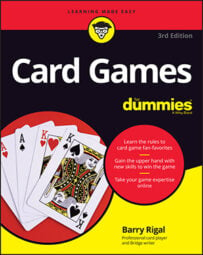After the dealer reveals the starting card (and claims his 2 points, if possible), both players have their first serious chance to score points. During the play of the cards, you take turns playing one card from each of your hands. Your goal is to form certain combinations of cards that score you points.
During gameplay, you must keep track of the cumulative value of the cards that have been played. The cards have the following values:
Aces are low and represent 1 point.
All court cards — kings, queens, and jacks — count 10 points each.
The numeric cards get their face value; for example, a 3 is worth 3 points.
Playing a hand at Cribbage
Here’s how to proceed:
The pone leads by putting one card face-up in front of her position and announcing the cumulative total of the value of the cards. In this case, the total is the value of her card. Incidentally, you can’t score on the first play.
The dealer then plays a card and calls out the combined total of the value of the two cards. The dealer then marks up any points that he scores in the process (see below).
Play continues with the pone playing another card and calling out the cumulative total of that first, second, and third cards played. The pone scores up points, if appropriate. This process continues throughout the hand.
The crib plays no part in the play of the cards. And only the dealer can use the crib, in the second phase of the game.
Each player keeps the played cards face-up in front of his or her position instead of mixing the two hands, and all the cards remain visible during the hand. Although the played cards can form combinations with the other player’s hand, both players keep their cards in a separate pile.
You can play any card at any time, with the following exception: During play, the cumulative total of the value of the cards can’t exceed 31 points. Sooner or later (usually sooner), one player finds herself unable to play a card without taking the total over 31. When this happens, she passes, saying “Go” to the other player, who must play any legal cards if he can. By playing the last card, he scores 1 point, which is called 1 point for go. However, if either player can take the total to exactly 31 points, he or she gets 2 points for doing so; if you have already scored 1 point for go, you only get 1 more point for bringing the total to 31.
When the total value of the cards reaches 31, or when neither player has a legal card to play, both players turn over their played cards, leaving them on the table, and start off anew with their remaining unplayed cards. The player that had to pass and conceded 1 point for go is the first to play, and both players take turns again to play their remaining cards. Again, the last to play scores 1 point — or 2, if he takes the total to exactly 31 points.
As you can see, the dealer must score at least 1 point in the play, no matter what happens; because he plays second, he’s bound to score the 1 point for playing the last card during some phase of the play.
Types of combinations in a Cribbage game
The idea of the play phase of the game described above is to score points by achieving any of the following combinations of cards:
If you bring the cumulative total of your cards and your opponent’s cards to 15, you score 2 points.
If you match, or pair, the card played most recently by your opponent (or your own most recent card if you have just scored one for go), you score 2 points. For example, if the pone puts down a 10, you score 2 points by playing a 10 in another suit.
If you make a pair royale (play a third consecutive card of the same value), you score 6 points.
If you somehow manage to play a fourth consecutive card of the same value, you achieve the rare feat of a double pair royale, which scores you 12 points. Don't expect to see this very often.
If you and your opponent play cards in consecutive order that form sequences, you score points for the length of the sequence. A sequence or run means, for example, 7-8-9, 4-2-3, or J-Q-K. If three cards are played consecutively (two by one player, one by the other), that can make up a sequence, and the player who puts down the third card scores 3 points. A fourth card in sequence scores four points, and so on.
Be careful with sequences! The cards don’t necessarily have to be played in sequential order for the sequence to register, and the suits of the cards are irrelevant. If player one plays a 7, player two plays a 6, and then player one plays a 5, it counts as a valid sequence, but so do the cards played in the order 5-7-6 or 7-5-6.
After the play restarts after the point for go or the total has been brought to 31, the old played cards are turned over, and you can’t pair up or make a sequence from what has been played before.

